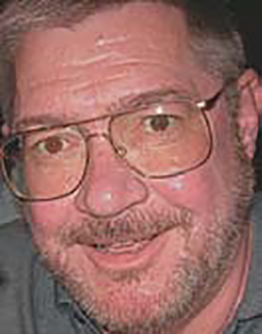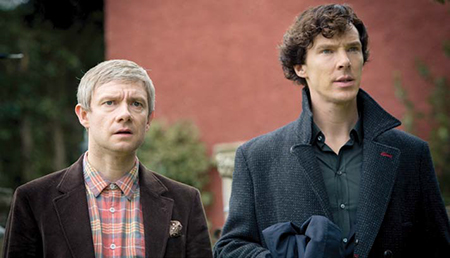Creating Different Concepts Of Reality Through Editing

Jay Ankeney
Editors rejoice. Every year the Creative Arts Awards given out by the Academy of Television Arts and Sciences heralds the greatest achievement in our craft. When the 2014 ceremony awarded the Emmy for “Outstanding Single-Camera Picture Editing For A Miniseries Or A Movie,” it was not only a great triumph for winner Yan Miles; it was also the fulfillment of a promise for me.
When I first saw “Sherlock: His Last Vow,” on PBS’s Masterpiece Theater last February— which garnered the statuette for Yan—I was so impressed with the editing in it that it became part of my permanent archive.
In case you haven’t seen the series, it is an updated version of Sir Arthur Conan Doyle’s Sherlock Holmes detective stories created by Steven Moffat and Mark Gatiss. It stars Benedict Cumberbatch (who also won a Prime Time Emmy this year for “Outstanding Lead Actor”) as Sherlock Holmes and Martin Freeman as Doctor John Watson.
THE NEW SHERLOCK HOLMES
Just as Conan Doyle empowered his 19th century sleuths with the latest scientific technology of their pre-mass communications age, this new version brings the pair into the 21st century, giving them access to cell phones, GPS and the Internet to help them solve their cases. But, true to form, it is a combination of Holmes’ expansive intellect and Watson’s ineffable “What do you mean?” kind of curiosity that leads to the final conclusion.
Also, in case you haven’t seen the series, we are going to assiduously avoid revealing any spoilers here in discussing this episode. Written by Steven Moffat and directed by Nick Hurran, “His Last Vow” was based on the original tale “Adventure of Charles Augustus Milverton,” except this time the sinister blackmailer/newspaper magnate is called Charles Augustus Magnussen (played by Lars Mikkelsen) patterned after the historical character Charles Augustus Howell.

From left: Martin Freeman as John Watson and Benedict Cumberbatch as Sherlock Holmes What makes this episode especially fascinating is that the team of Moffat, Hurran and Miles, backed up by assistant editor, Gareth Mabey, took a unique approach to telling the story through editing. Instead of just exploiting editing’s creative power of juxtaposing two disparate images to create a third, unique concept in the audience’s mind, they expanded this illustrated abstraction to the level of contrasting the different concepts of reality held by Sherlock and his antagonist maximus, Magnussen, through various depictions of their mental universes, or what they call their “Mind Palace.”
The episode actually opens with a scene of Watson searching for his neighbor’s son in a broken down crack house, filled with stairs and hallways that partially represent Watson’s own Mind Palace. Later we see Magnussen being questioned by a parliamentary committee and the subliminal graphics on the screen reveal him building his internal Mind Palace by gathering “Pressure Points” on his enemies through which he can blackmail them.
Holmes, as usual, constructs his uniquely elaborate Mind Palace by gathering, analyzing and deducing his iconic vision of reality through his unbound intellect. This multilevel structure gave Miles plenty of material to edit with.
Miles told me he had worked previously with director Hurran, but regretted that he had to pass on cutting Hurran’s “50th Anniversary of Dr. Who,” which the BBC cited as the most watched TV drama of 2013. So when Hurran asked Miles to work on his first Sherlock episode in the series’ latest incarnation, Miles jumped at the chance.
FUN IN THE EDIT BAY
Miles said that visualizing the character’s thoughts constructing their Mind Palace with graphic words on the screen came from the script, but the idea of speeding up their content to reflect the intelligence of the thinker came up in the edit bay. In fact, when Magnussen tries to read Holmes’s Mind Palace, the text filling Magnussen’s Pressure Points scrolls by so fast it is illegible to the audience.
“That was us having fun in the edit bay,” Miles said. Actually, with the advantage of slo-mo playback in my home theater, I discovered that the blur of words zipping past the screen are a rapid repetition of seven index entries indicating story notes, each annotated with “see file.”
Later, in a paroxysm of violence during a scene that you will later thank me for not sharing the outcome, Holmes is shot (I won’t say by whom). As he falls backward at 2,000 fps recorded with a Phantom Flex high-speed camera, Miles intercut an elaborate tour through Holmes’s own Mind Palace, revealing his loves and his fears, until, on the verge of death, he hears his arch nemesis James Moriarty saying “Watson is in danger!” Sherlock snaps himself out of his death spiral and, as only Holmes could, wills his heart to beat again.
“Nick Hurran loves using multiple speed shots in his scenes,” Miles said, “and this became a treat for an editor with all the rich material I was provided. The way we structured it, all the mental convolutions happen between the top of Holmes’ fall and when his body reaches the ground. This effect makes it a very integral scene.”
Although Miles said that every scene in this Masterpiece Theater episode was challenging, the one he remembers most fondly was intercutting a flat-lined heart monitor with Holmes mentally willing himself to come back to life as he drags his body up some stairs to the ER. “Bang” goes his hand on the railing, and “blip” echoes the spike on the screen until the great detective is brought back to life.
“Holmes pounds on the bannister, forcing his heart to start beating,” Miles recalled. “It was a very tricky line to walk without going too far. It took quite a few versions before everyone was satisfied.”
The most difficult scene, however, was the finale in which there is a major emotional confrontation between Dr. Watson and Magnussen.
“Nick covered Sherlock thoroughly through the scene, but always in the background,” Miles recalled. “In an early cut, we saw Sherlock getting very disturbed about the way Magnussen was emotionally tormenting Watson, and Benedict Cumberbatch pulled it off so well he over-dominated the scene.
So in the end we went with a more neutral version that implied Sherlock was allowing the battle of power to continue between his friend and the persistent fiend. Nick Hurran gave me several shots recorded at half speed, which punctuates the drama, and we even adjusted the color timing as the scene progressed and evening falls to heighten the tension.”
Who wins out in the end? I promised I wouldn’t reveal it and hope you can catch “Sherlock: His Last Vow” the next time it airs on Masterpiece Theater (or you can catch it on-demand). But you’ll want to watch it twice to catch all the nuances that Yan Miles helped the creative team put into it. After all, as in the line Holmes borrowed from Shakespeare’s “Henry V,”—“Come Watson, the game is afoot!”
Jay Ankeney is a freelance editor and post-production consultant based in Los Angeles. Write him atJayAnkeney@mac.com.
Get the TV Tech Newsletter
The professional video industry's #1 source for news, trends and product and tech information. Sign up below.
